

News
SpaceX could upgrade Starlink constellation with tens of thousands of satellites
Filings and an official statement confirm that SpaceX could eventually build a Starlink internet constellation with tens of thousands of satellites, several times more than the company’s already ambitious plans.
“As demand escalates for fast, reliable internet around the world, especially for those where connectivity is non-existent, too expensive or unreliable, SpaceX is taking steps to responsibly scale Starlink’s total network capacity and data density to meet the growth in users’ anticipated needs.”
SpaceX – October 15th, 2019
Uncovered through regulatory filings published on the International Telecommunications Union’s (ITU) eSubmission portal, the FCC filed documents hinting at plans for tens of thousands of new communications satellites. It was eventually confirmed by the ITU and eventually the company itself that SpaceX was behind the new filings, altogether accounting for up to 30,000 additional Starlink satellites.

Prior to this new filing, the ceiling for SpaceX’s Starlink satellite internet constellation was set around 11,900 spacecraft – 4400 in several low Earth orbits (LEO) and another 7500 in very low orbit (VLEO). Put simply, even the most ardent supporters and potential benefactors of such a colossal satellite constellation have never taken those particular numbers all that seriously – 12,000 satellites is nearly six times as many operational spacecraft currently in orbit.
To build even a fraction as many satellites would take resources on the order of a small country without a revolution in satellite manufacturing and mass production. Assuming a cost as low as $5 million per satellite (more or less unprecedented), launching just the first 4400-satellite segment would cost SpaceX a minimum of $22 billion, while the full 11,900 would be more like $60 billion.

And yet, as improbable as it sounds next to today’s satellite production status quo, CEO Elon Musk indicated that SpaceX’s very first 60 Starlink prototypes – launch in May 2019 – cost less than the launch itself. This implies that the cost of each of those beta spacecraft was probably $1 million at most and likely closer to $500,000 apiece. Around that price point, launching thousands of relatively high-performance satellites becomes far more reasonable, even if the figures are still substantial.
4400 satellites would become ~$2 billion, while ~12,000 satellites would become $6 billion. Combined with SpaceX’s new ITU filings, the current maximum of ~42,000 satellites might cost something like $20 billion – a huge price tag, no doubt, but far from impossible. Important to note is that SpaceX almost certainly plans to begin drawing significant income from its Starlink constellation after as few as several hundred satellites have been launched. SpaceX has already raised more than $1 billion to get Starlink close to that point.

Also critical is the fact that building hundreds (let alone thousands) of satellites annually will allow SpaceX to tap into economies of scale quite literally unprecedented in the history of satellite manufacturing, meaning that it’s hard to accurately judge how low the per-satellite cost might eventually fall. Regardless, at the moment, SpaceX’s filings for an additional 30,000 possible satellites are undoubtedly more of an act of “just in case” than a sign of firm plans.
In the present, SpaceX has plans for as many as four additional Starlink v1.0 launches between now and the end of 2019, although it looks likely that that may shrink to 1-2 missions. The next Starlink mission (deemed Starlink 1) is expected no earlier than late-October or November.
Check out Teslarati’s Marketplace! We offer Tesla accessories, including for the Tesla Cybertruck and Tesla Model 3.

News
Nvidia CEO Jensen Huang explains difference between Tesla FSD and Alpamayo
“Tesla’s FSD stack is completely world-class,” the Nvidia CEO said.

NVIDIA CEO Jensen Huang has offered high praise for Tesla’s Full Self-Driving (FSD) system during a Q&A at CES 2026, calling it “world-class” and “state-of-the-art” in design, training, and performance.
More importantly, he also shared some insights about the key differences between FSD and Nvidia’s recently announced Alpamayo system.
Jensen Huang’s praise for Tesla FSD
Nvidia made headlines at CES following its announcement of Alpamayo, which uses artificial intelligence to accelerate the development of autonomous driving solutions. Due to its focus on AI, many started speculating that Alpamayo would be a direct rival to FSD. This was somewhat addressed by Elon Musk, who predicted that “they will find that it’s easy to get to 99% and then super hard to solve the long tail of the distribution.”
During his Q&A, Nvidia CEO Jensen Huang was asked about the difference between FSD and Alpamayo. His response was extensive:
“Tesla’s FSD stack is completely world-class. They’ve been working on it for quite some time. It’s world-class not only in the number of miles it’s accumulated, but in the way it’s designed, the way they do training, data collection, curation, synthetic data generation, and all of their simulation technologies.
“Of course, the latest generation is end-to-end Full Self-Driving—meaning it’s one large model trained end to end. And so… Elon’s AD system is, in every way, 100% state-of-the-art. I’m really quite impressed by the technology. I have it, and I drive it in our house, and it works incredibly well,” the Nvidia CEO said.
Nvidia’s platform approach vs Tesla’s integration
Huang also stated that Nvidia’s Alpamayo system was built around a fundamentally different philosophy from Tesla’s. Rather than developing self-driving cars itself, Nvidia supplies the full autonomous technology stack for other companies to use.
“Nvidia doesn’t build self-driving cars. We build the full stack so others can,” Huang said, explaining that Nvidia provides separate systems for training, simulation, and in-vehicle computing, all supported by shared software.
He added that customers can adopt as much or as little of the platform as they need, noting that Nvidia works across the industry, including with Tesla on training systems and companies like Waymo, XPeng, and Nuro on vehicle computing.
“So our system is really quite pervasive because we’re a technology platform provider. That’s the primary difference. There’s no question in our mind that, of the billion cars on the road today, in another 10 years’ time, hundreds of millions of them will have great autonomous capability. This is likely one of the largest, fastest-growing technology industries over the next decade.”
He also emphasized Nvidia’s open approach, saying the company open-sources its models and helps partners train their own systems. “We’re not a self-driving car company. We’re enabling the autonomous industry,” Huang said.
Elon Musk
Elon Musk confirms xAI’s purchase of five 380 MW natural gas turbines
The deal, which was confirmed by Musk on X, highlights xAI’s effort to aggressively scale its operations.

xAI, Elon Musk’s artificial intelligence startup, has purchased five additional 380 MW natural gas turbines from South Korea’s Doosan Enerbility to power its growing supercomputer clusters.
The deal, which was confirmed by Musk on X, highlights xAI’s effort to aggressively scale its operations.
xAI’s turbine deal details
News of xAI’s new turbines was shared on social media platform X, with user @SemiAnalysis_ stating that the turbines were produced by South Korea’s Doosan Enerbility. As noted in an Asian Business Daily report, Doosan Enerbility announced last October that it signed a contract to supply two 380 MW gas turbines for a major U.S. tech company. Doosan later noted in December that it secured an order for three more 380 MW gas turbines.
As per the X user, the gas turbines would power an additional 600,000+ GB200 NVL72 equivalent size cluster. This should make xAI’s facilities among the largest in the world. In a reply, Elon Musk confirmed that xAI did purchase the turbines. “True,” Musk wrote in a post on X.
xAI’s ambitions
Recent reports have indicated that xAI closed an upsized $20 billion Series E funding round, exceeding the initial $15 billion target to fuel rapid infrastructure scaling and AI product development. The funding, as per the AI startup, “will accelerate our world-leading infrastructure buildout, enable the rapid development and deployment of transformative AI products.”
The company also teased the rollout of its upcoming frontier AI model. “Looking ahead, Grok 5 is currently in training, and we are focused on launching innovative new consumer and enterprise products that harness the power of Grok, Colossus, and 𝕏 to transform how we live, work, and play,” xAI wrote in a post on its website.
Elon Musk
Elon Musk’s xAI closes upsized $20B Series E funding round
xAI announced the investment round in a post on its official website.

xAI has closed an upsized $20 billion Series E funding round, exceeding the initial $15 billion target to fuel rapid infrastructure scaling and AI product development.
xAI announced the investment round in a post on its official website.
A $20 billion Series E round
As noted by the artificial intelligence startup in its post, the Series E funding round attracted a diverse group of investors, including Valor Equity Partners, Stepstone Group, Fidelity Management & Research Company, Qatar Investment Authority, MGX, and Baron Capital Group, among others.
Strategic partners NVIDIA and Cisco Investments also continued support for building the world’s largest GPU clusters.
As xAI stated, “This financing will accelerate our world-leading infrastructure buildout, enable the rapid development and deployment of transformative AI products reaching billions of users, and fuel groundbreaking research advancing xAI’s core mission: Understanding the Universe.”
xAI’s core mission
Th Series E funding builds on xAI’s previous rounds, powering Grok advancements and massive compute expansions like the Memphis supercluster. The upsized demand reflects growing recognition of xAI’s potential in frontier AI.
xAI also highlighted several of its breakthroughs in 2025, from the buildout of Colossus I and II, which ended with over 1 million H100 GPU equivalents, and the rollout of the Grok 4 Series, Grok Voice, and Grok Imagine, among others. The company also confirmed that work is already underway to train the flagship large language model’s next iteration, Grok 5.
“Looking ahead, Grok 5 is currently in training, and we are focused on launching innovative new consumer and enterprise products that harness the power of Grok, Colossus, and 𝕏 to transform how we live, work, and play,” xAI wrote.








